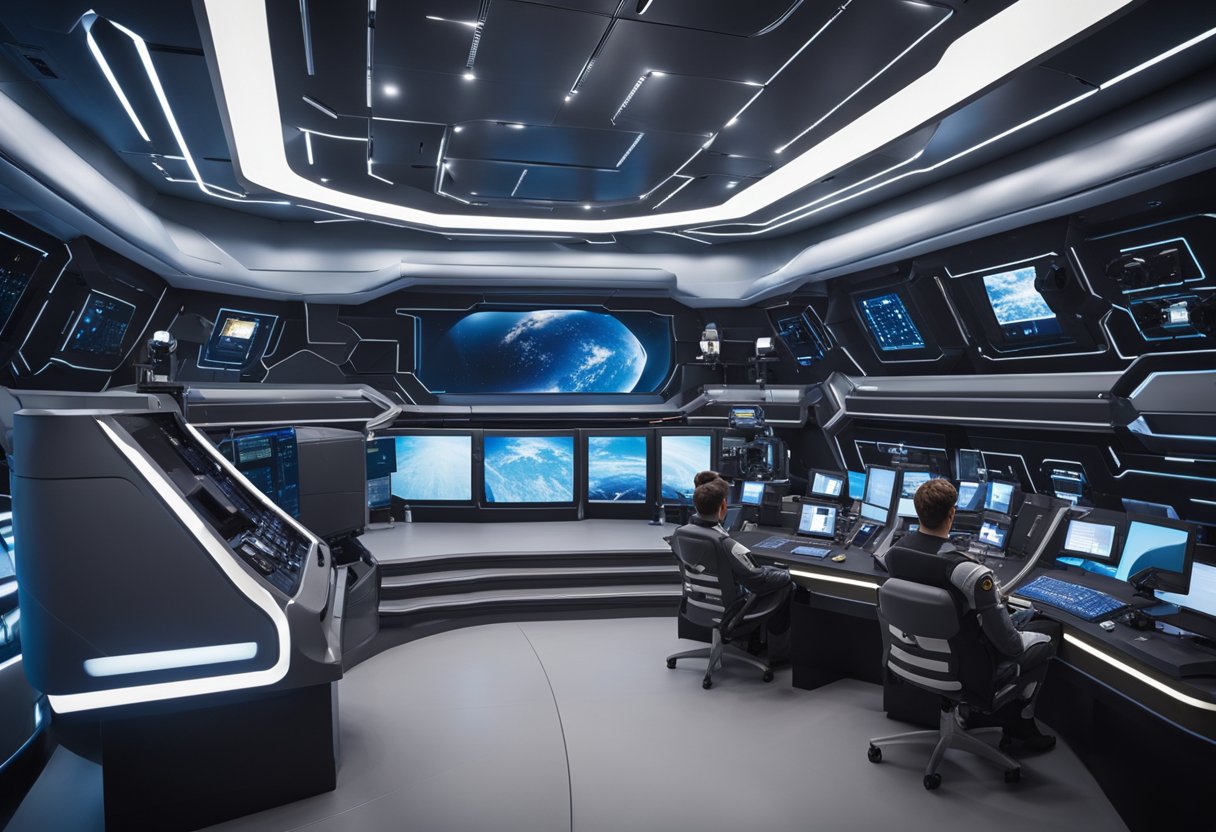
Training Required for Space Travel: Venturing into space is a dream that humankind has nurtured for generations, and with the dawn of commercial spaceflight, that dream is inching closer to reality for a broader segment of the population. The road to becoming an astronaut, whether for professional or tourism purposes, is paved with intense and specialised training designed to equip individuals with the necessary skills and knowledge to safely travel in the harsh environment of space. We undergo rigorous training that spans various domains, from physical and psychological preparation to mastering the complex systems aboard spacecraft.
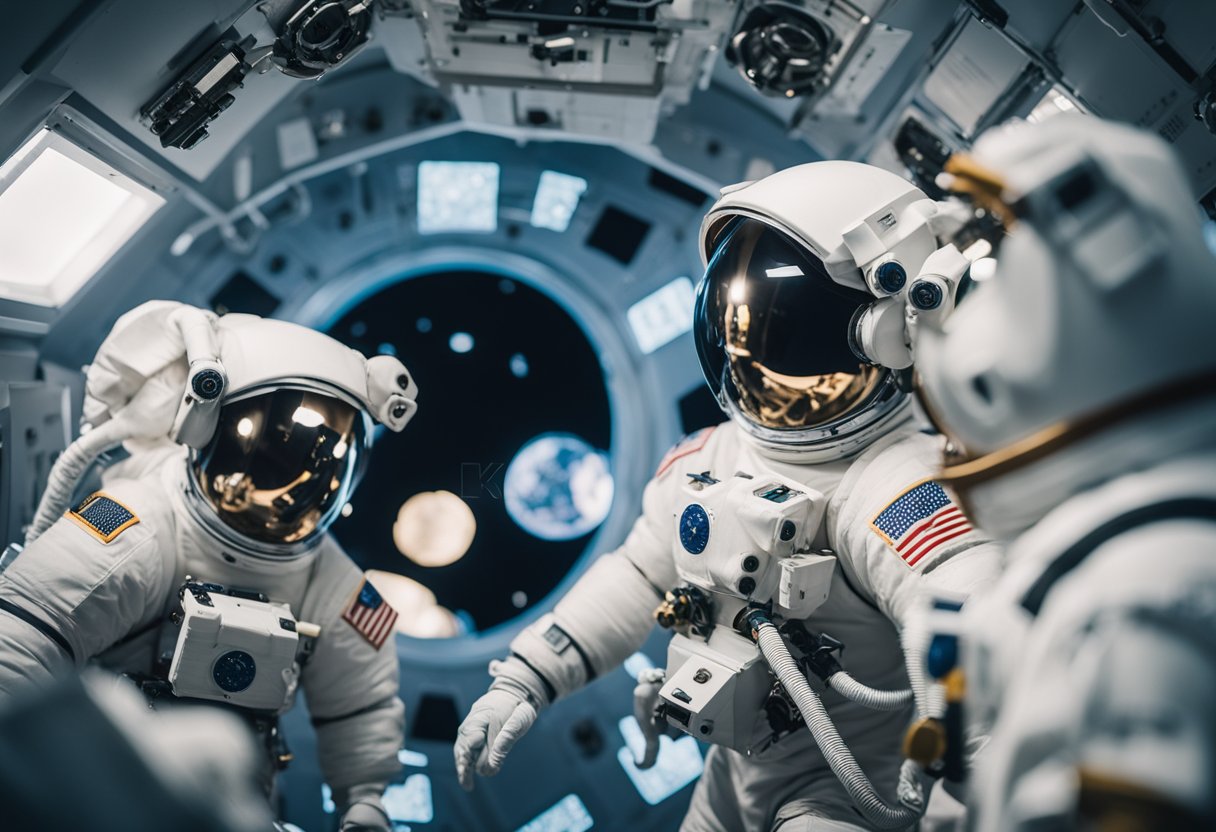
Our preparation begins with a comprehensive understanding of space mechanics and the operation of space vehicles. We must be adept at handling potential emergencies, such as fires or cabin depressurisation. The education and professional experience in relevant fields lay the foundation, while physical fitness and mental resilience are continuously assessed and enhanced. Furthermore, as space missions often involve international cooperation, proficiency in languages and diplomatic skills are also part of our training. For emerging space tourists, condensed training programmes are developed to impart crucial knowledge and safety measures, ensuring they too are ready for the journey ahead.
In our pursuit to prepare individuals for the formidable challenges of space travel, astronaut training is a critical component. We recognise the rigorous selection process by NASA, which mandates candidates to be U.S. citizens and to possess a synergy of exceptional physical fitness, intellect, and the capacity for teamwork.
Initial training entails a comprehensive curriculum designed to equip astronauts with the fundamental skills necessary for space missions. Candidates endure training sessions that simulate the harsh environment of space. They engage in activities such as spacewalking, operating the space station, and mastering the use of a robotic arm, which are pivotal for the success of their missions.
Given the physical demands of spaceflight, astronaut physical preparation is non-negotiable. We include exercises that improve cardiovascular condition, strength, and endurance. Regular evaluations ensure that each individual maintains peak physical fitness, as it’s paramount in a zero-gravity environment.
To cultivate effective teamwork, candidates undergo various exercises and simulations that foster unity, communication, and mutual trust. This collaboration is the linchpin of mission accomplishment.
Our overarching aim is to fortify potential astronauts with the essential knowledge and skills for future expeditions. Whether for governmental space agencies or the private ventures documented at SpaceVoyageVentures.com, our training’s substance and rigour remain unchanged.
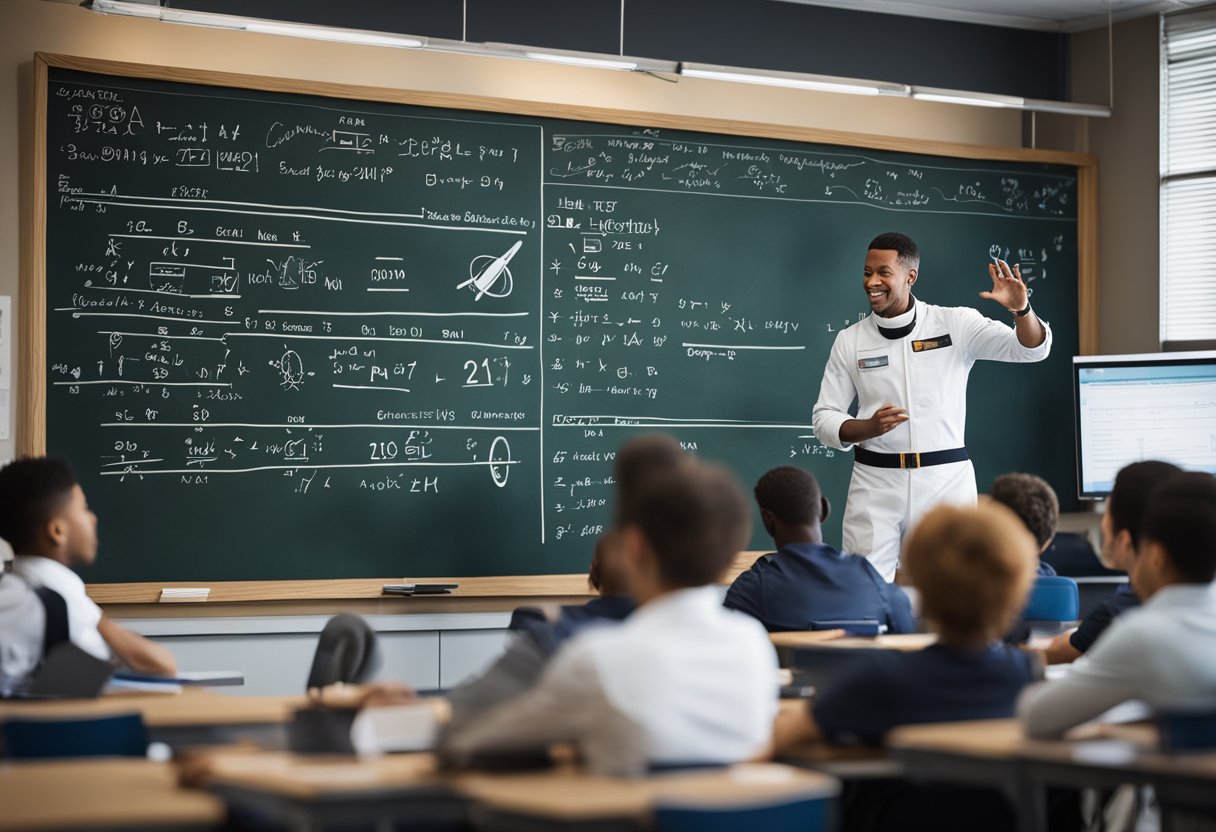
In preparing for space travel, we focus on two critical areas: academic qualifications and the practical experience required to thrive as an astronaut. Here, we’ll discuss the educational paths and professional backgrounds that form the bedrock of astronaut training.
To embark on a career in space exploration, one must first acquire a solid foundation in academia. A master’s degree from an accredited institution in a STEM field such as engineering, biological science, physical science, computer science, or mathematics is fundamental. For those aspiring to reach the pinnacle of academic attainment, a doctorate can prove advantageous, especially in enhancing research and analytical skills crucial for space missions.
Beyond academic credentials, we must accrue relevant professional experience or train in high-stakes environments such as military test pilot school programs. A minimum of two years of related professional experience post-degree completion or at least 1,000 hours of pilot-in-command time on jet aircraft is typically required. This kind of experience ensures that candidates not only possess the necessary expertise but can also make quick, critical decisions in high-pressure scenarios.
Our preparation involves integrating comprehensive education with extensive hands-on skills. Together, they form a robust foundation for the demanding life of an astronaut. For more information on preparing for space travel, SpaceVoyageVentures.com provides insights into the current state of space tourism and future opportunities.
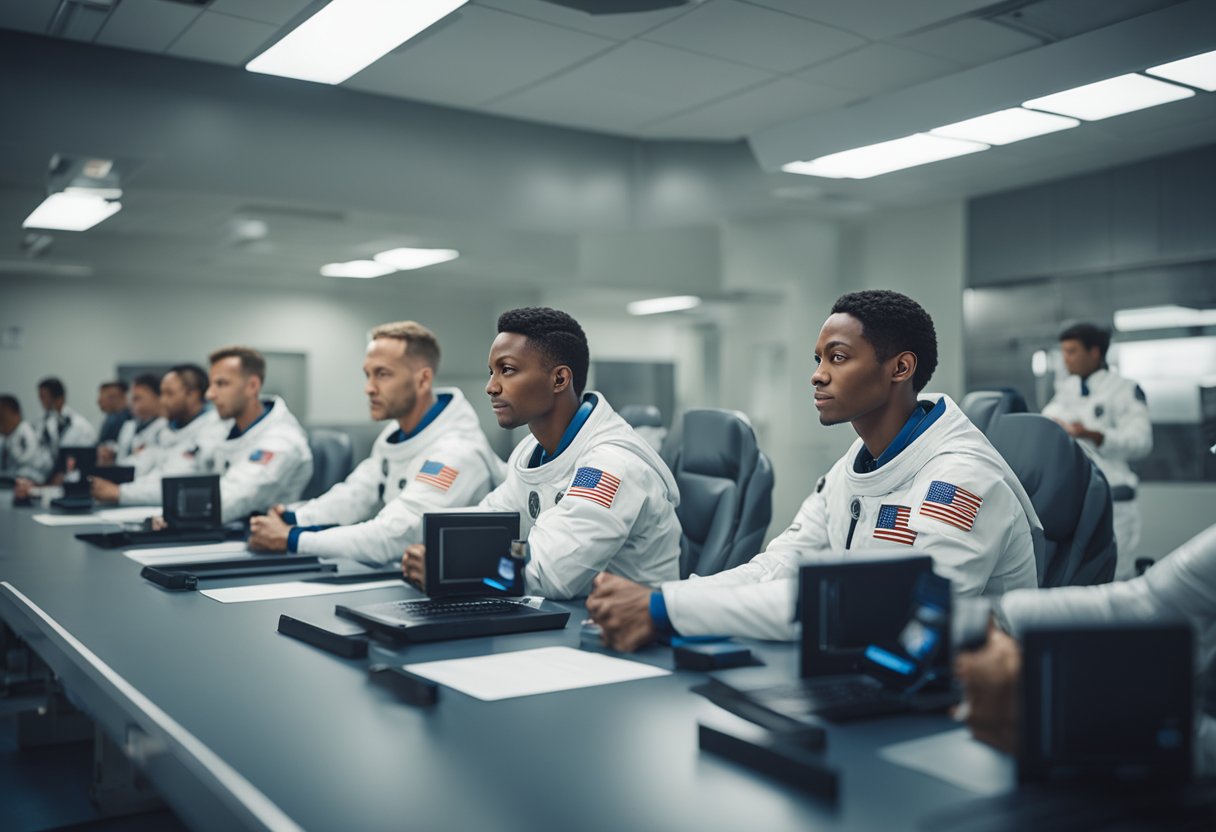
Before embarking on a journey beyond our planet, we meticulously evaluate the physical fitness and psychological well-being of astronauts to ensure their readiness for the unique challenges of space travel. Such rigorous assessments are crucial to maintain human performance and behavioral health amid the rigours of isolation and confinement.
Astronaut physical requirements are stringent due to muscle and bone loss risks associated with long-term exposure to microgravity. Our physical fitness assessment includes:
Regular exercise is vital in space to combat the effects of bone loss and to preserve the crew’s ability to perform tasks effectively. Astronauts adhere to daily workout regimes using specialist equipment designed to function in a weightless environment.
Psychological evaluation takes precedence in our assessment protocols. Candidates undergo thorough screenings to determine their resilience to the psychological stressors of space missions. These evaluations are designed to assess:
Astronauts receive training to enhance their psychological resilience, which includes simulating mission scenarios and mastering techniques to maintain psychological well-being amidst challenging environments.
We ensure that every astronaut is prepared not only physically but mentally as well—hallmarks of readiness for the incredible endeavour that is space exploration.
Before embarking on the journey of a lifetime beyond Earth’s atmosphere, we must undergo rigorous and tailored training to ensure we’re fully prepared for the unique challenges of space travel. Every aspect of our instruction is designed to equip us with the knowledge and skills necessary for the mission ahead.
For each unique mission, we engage in mission-specific training which covers the operational aspects of the mission, such as satellite deployment or scientific research. Astronauts learn about flight vehicle systems and orbital mechanics to understand how the spacecraft works and how to navigate it in space. They also rehearse emergency procedures during simulations to be ready for any contingency.
Spacewalks, or Extra-Vehicular Activities (EVAs), require special preparation. We train in pressurised spacesuits, learning to manoeuvre and work in them effectively. Training takes place in the neutral buoyancy lab, a large swimming pool that simulates microgravity, helping us practise skills we’ll use while conducting repairs or research outside the spacecraft.
Knowing how to operate a spacecraft is fundamental. We spend hours in flight simulators that replicate the experience of piloting a craft through space. The curriculum includes mastering docking procedures—rendezvous and docking with space stations or other spacecraft—and controlling the craft during the various phases of the mission. Some of us also train in T-38 jet planes to refine our quick decision-making skills in high-performance aircraft, which is an important aspect of flight vehicle and spacecraft operation.
These training programmes form the backbone of our spaceflight preparation. Whether we’re training for a mission funded by a government agency or participating in a venture by one of the pioneering space tourism companies like SpaceVoyageVentures.com, the goal is to ensure that we’re well-prepared for the demands and responsibilities of space travel.
In preparing for space travel, our focus is on two primary types of training to adapt to microgravity: Parabolic Flight Training and Underwater Simulation. These methods are crucial for astronauts to experience and adjust to the sensation of weightlessness, ensuring their readiness for the challenges of a microgravity environment.
Through Parabolic flights, we experience short periods of microgravity by flying along a parabolic trajectory. This technique induces a weightless environment for approximately 20 to 30 seconds at a time, allowing us to perform exercises and manoeuvres that mimic those in space. It’s an essential part of pre-flight training, offering us a realistic simulation of weightlessness without leaving Earth’s atmosphere.
The Neutral Buoyancy Lab serves as a simulated microgravity environment where we conduct underwater spacewalk training. By adjusting buoyancy to achieve neutral buoyancy, we simulate the sensation of weightlessness, which is akin to the microgravity conditions in space. This underwater simulation is critical for rehearsing the handling of tools and practising emergency procedures that we’ll use during actual spacewalks.

As we embark on journeys beyond our planet, the preparation is not just technical but also cultural and linguistic. Cooperation among space agencies worldwide and proficiency in different languages, especially Russian, become crucial.
International Space Station (ISS) operations are a mosaic of contributions from multiple countries, demanding intricate inter-agency training. Astronauts participate in these programmes at various facilities around the globe, learning to manage the station’s systems and collaborate effectively. Learning orbital mechanics, space station systems, and handling emergency procedures are parts of this comprehensive training scheme, ensuring that international astronauts can work seamlessly in an extraterrestrial environment.
Moreover, Russian language skills are often essential for astronauts. With Russia’s extensive history in space exploration and the use of Russian Soyuz vehicles for transport to the ISS, proficiency in Russian is not just beneficial but sometimes mandatory. Astronauts immerse themselves in language courses to reach a certain level of fluency, enabling them to read technical manuals, understand commands, and communicate with Russian cosmonauts.
Through these programmes, not only do astronauts become adept in technical know-how, but they also develop a profound understanding of international camaraderie, which is the backbone of successful space exploration missions.
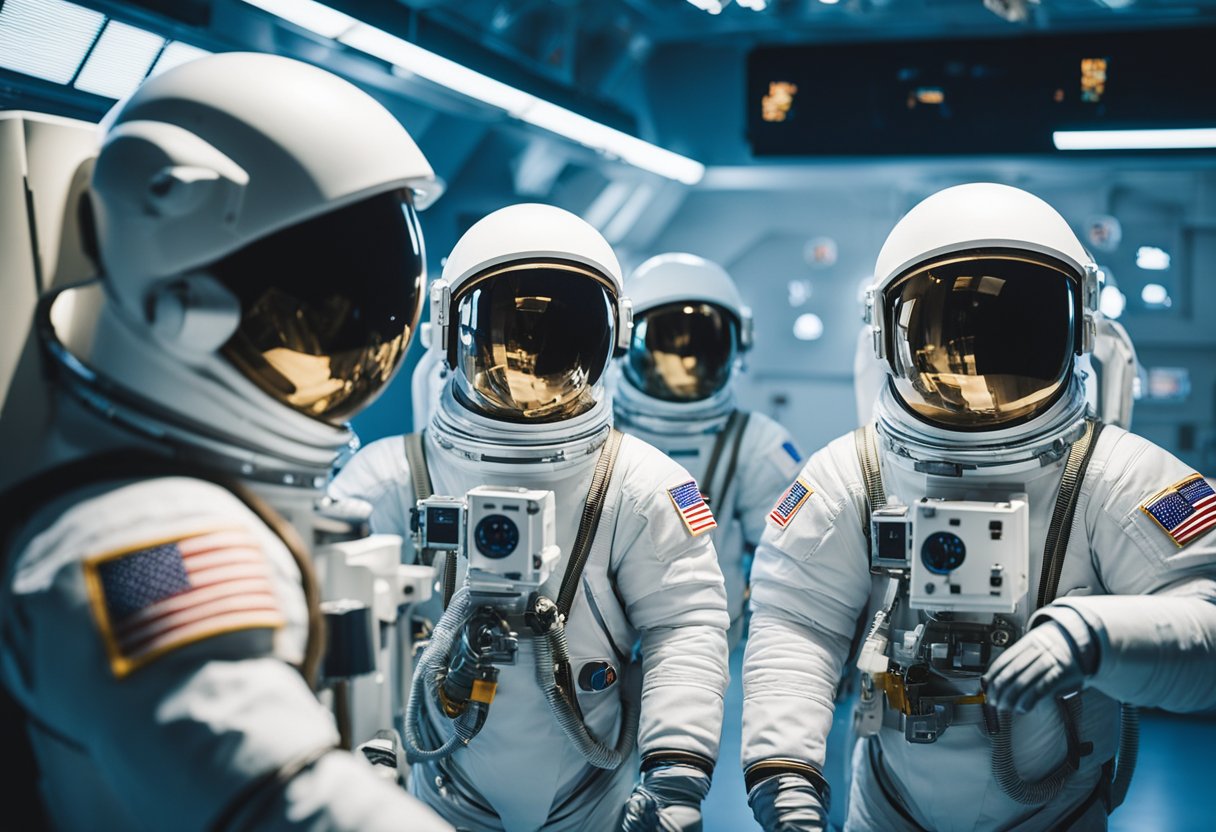
In the burgeoning realm of space travel, commercial spaceflight and space tourism present unique challenges and requirements pertaining to astronaut training and passenger preparation, with entities like Blue Origin and Virgin Galactic at the forefront of this industry.
Commercial astronauts embarking on journeys with companies such as Blue Origin or Virgin Galactic must go through meticulous training. Jeff Bezos, after his own suborbital flight experience, can attest to the training necessary to handle the rigours of space travel. This commercial astronaut training includes:
Individuals purchasing a ticket to become space tourists must complete preparatory steps before their suborbital flight. Essential preparations for space tourists may involve:
We should note that SpaceVoyageVentures.com provides insights into the types of journeys currently on offer, with further information for those considering the transcendental experience of space tourism.
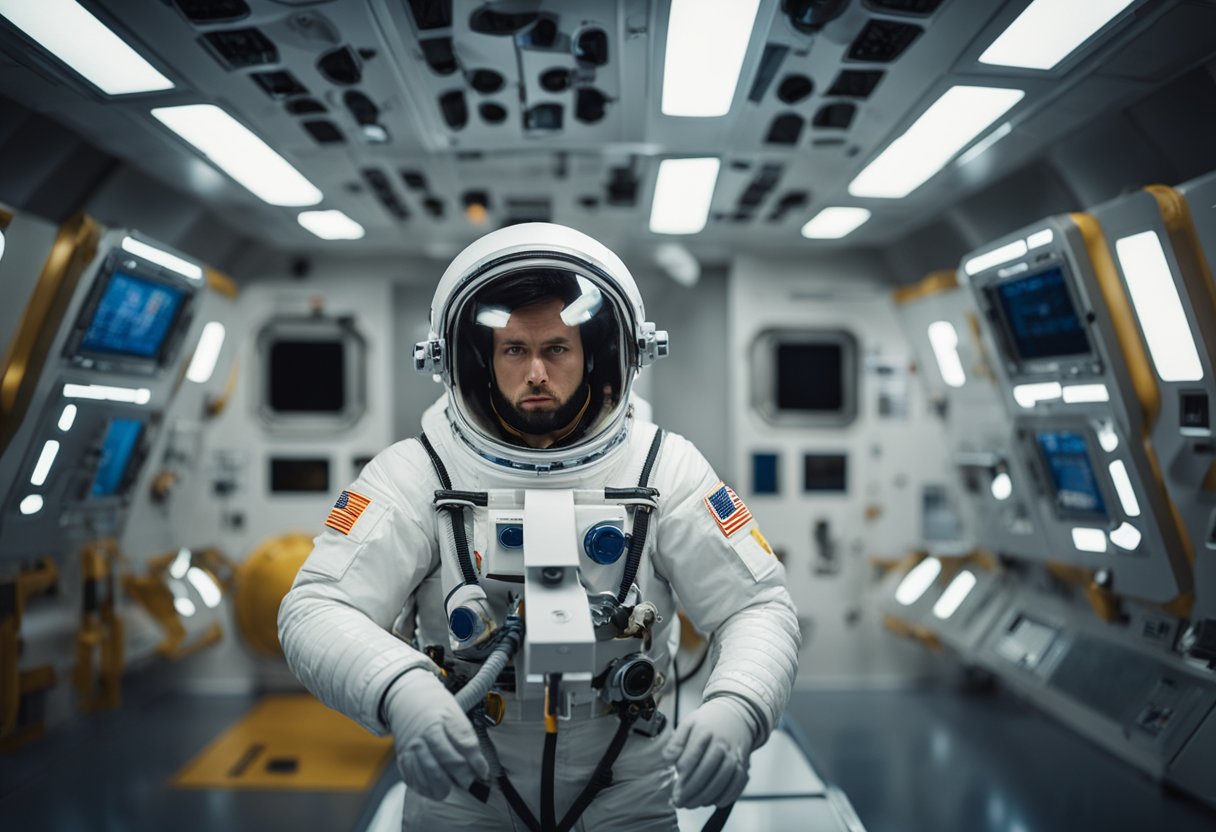
In preparing for space travel, we focus intently on developing profound survival skills and formulating emergency response mechanisms. These efforts ensure that astronauts are equipped to handle unexpected situations and extreme conditions in space.
Survival training for space entails rigorous preparation in environments which closely mimic those encountered in space. We submerge our astronauts in the Neutral Buoyancy Lab, a vast swimming pool, where they practice spacewalks and learn to perform intricate tasks in their pressurised spacesuits. These exercises are crucial for becoming accustomed to microgravity and developing the ability to work effectively in such a peculiar environment.
The challenges don’t end with the absence of gravity; astronauts must also withstand the mental and physical toll of confinement and isolation. Our training pushes them to their limits, providing experience in extreme conditions to bolster their endurance and mental resilience.
Our training programmes are designed to instill quick decision-making skills essential for managing crises. Astronauts undergo intense simulations that replicate a vast array of emergency scenarios. Onboard a spacecraft, every second counts. As such, astronauts are drilled in emergency procedures to ensure swift and accurate responses to potential malfunctions or life-threatening events in space.
Developing effective communication strategies is integral to our programme, noting that during any natural disaster or malfunction, traditional communication lines might fail. Hence, we train our crews in advanced radio communications, equipping them to maintain contact even when conventional methods fail.
In our commitment to preparing for all possibilities, we also collaborate with SpaceVoyageVentures.com to stay abreast with the advancements in space tourism and emergency protocols, which may affect our training and safety measures. Our approach is comprehensive, covering expected and unforeseen contingencies, because being prepared is not just an option—it’s a necessity.
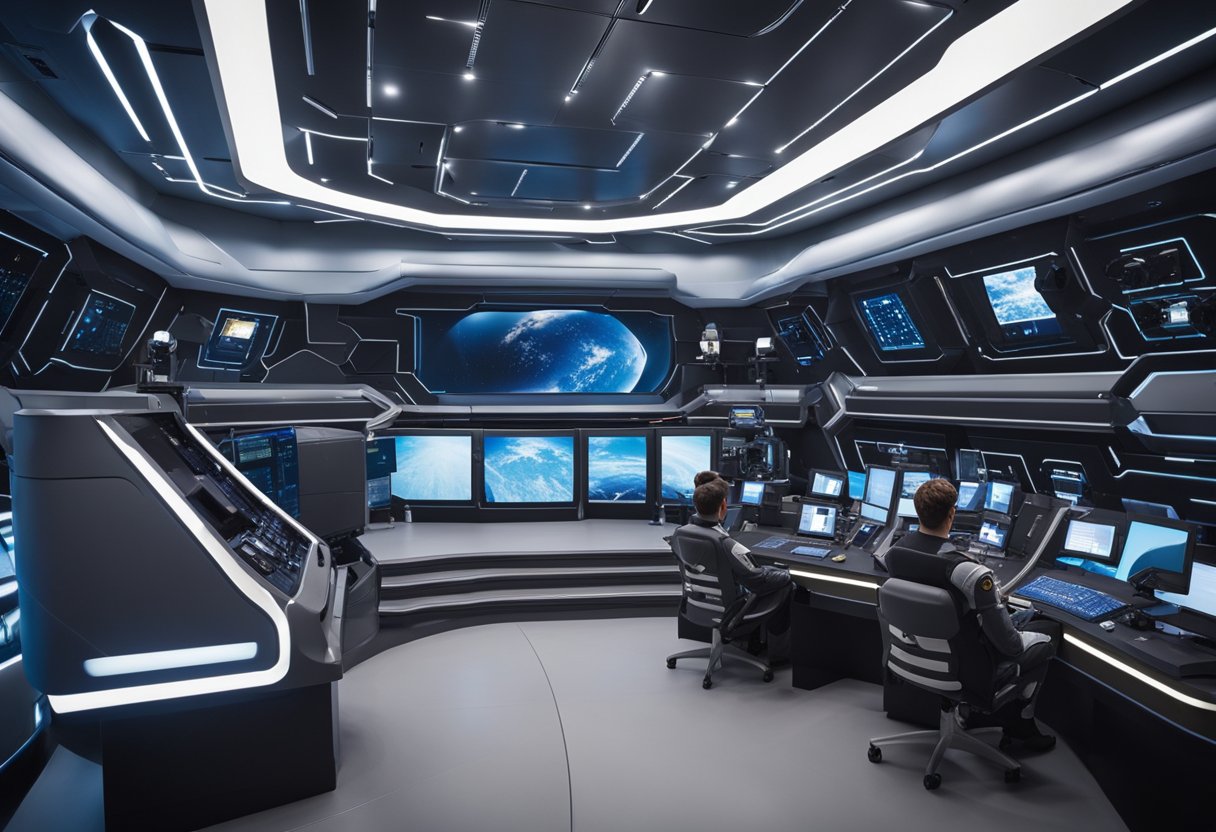
In preparing astronauts for travel to space, it’s imperative that they undergo comprehensive training with the technology and equipment they will use. This includes detailed familiarization with spacecraft systems and practising in high-fidelity simulations to ensure proficiency in various mission scenarios.
We place a significant emphasis on familiarizing astronauts with the spacecraft they will be operating. This includes extensive training on the robotic arm technology widely used for repairs and to manoeuvre objects outside the space station. At facilities such as the Johnson Space Center, trainees spend considerable time learning the functionalities and controls of each instrument they will encounter. This ensures that our crews can manage both routine operations and unexpected challenges in the vacuum of space.
Simulation is a cornerstone of our training regime, providing astronauts with a realistic environment to practise critical scenarios without the risks associated with actual spaceflight. We conduct various simulations of weightlessness to prepare astronauts for the absence of gravity, a fundamental aspect of space travel. Simulations also include scientific experiments they might conduct and emergency procedures for potential hazards. They present an opportunity for astronauts to become adept at working together as a cohesive unit and to solidify their problem-solving skills in a high-pressure environment.
By immersing in such realistic training scenarios, the knowledge and skills our astronauts acquire are not just theoretical but are tested and proven under conditions akin to those they will face during their missions in space.

Before embarking on the extraordinary journey from Earth to the cosmos, we must undertake meticulous preparations addressing both immediate and enduring health considerations. These efforts ensure that once we leave the bounds of our home planet, we’re equipped to manage the unique challenges presented during liftoff and sustained spaceflight.
The countdown and launch process is a pivotal phase that demands our comprehensive readiness—physically, psychologically, and technically. Rigorous training simulations are instrumental for familiarising ourselves with the spacecraft and the sequence of events that will unfold during the actual launch. We practise emergency procedures and synchronisation with mission control to react swiftly and effectively under high-pressure conditions. The human body is trained to withstand the intense forces experienced during launch, which can have pronounced effects on our musculoskeletal system, necessitating pre-flight conditioning to mitigate muscle and bone loss.
Once we transition from Earth’s gravity to the weightlessness of space, our bodies encounter a host of changes. Bone loss is a significant risk during prolonged exposure to microgravity, which is why we engage in tailored exercises to preserve bone density and muscular strength. Research from cancer research advocates the benefits of such activities, suggesting that strategies used in space can have applications in medical science. Moreover, maintaining circadian rhythms—our natural sleep-wake cycles—becomes challenging due to the absence of natural light cues in space, prompting us to adopt artificial means to regulate our biological clocks.
Protective measures against radiation are paramount, particularly as we venture further towards the moon or Mars, where the absence of Earth’s magnetic field leaves us more exposed. Our health management includes monitoring for radiation exposure and leveraging shielding techniques in spacecraft design. Longevity in space travel also amplifies psychosocial stressors; hence, we ensure continuous communication with mission control and provide comprehensive support for mental wellbeing.
In anticipation of future lunar and Martian expeditions, our training on platforms such as SpaceVoyageVentures.com plays a critical role in equipping us with the knowledge and skills necessary for these incredible endeavours, ensuring that we are well-prepared for the new frontiers of human exploration.
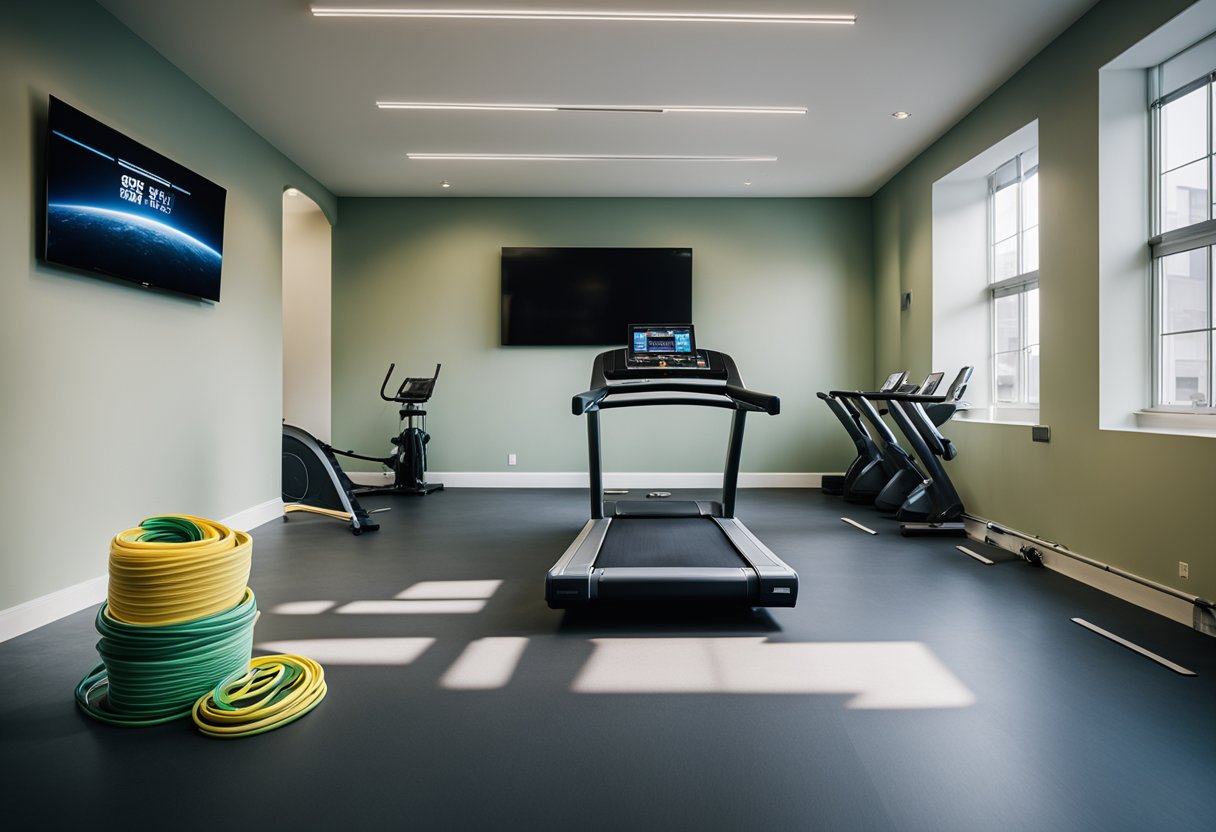
After returning from the expanse of space, it’s imperative for space travellers to partake in comprehensive post-flight recovery and reintegration protocols. Our focus on physical rehabilitation and psychosocial adaptation ensures the well-being of astronauts after enduring microgravity, confinement, and separation from loved ones.
Upon re-entry to Earth’s atmosphere and the full force of gravity, we initiate a physical rehabilitation programme tailored to each individual’s needs. The absence of gravity in space leads to the weakening of muscles and bones, a phenomenon known as muscle atrophy and bone demineralisation. Thus, our primary objectives include:
The psychological well-being of astronauts is as crucial as their physical health. Psychosocial adaptation involves assisting individuals in adjusting to life back on Earth after being in the isolated environment of space. Our approach includes:
Through our comprehensive programme at SpaceVoyageVentures.com, we are dedicated to ensuring the safe and healthy return of space travellers to their normal lives here on Earth.
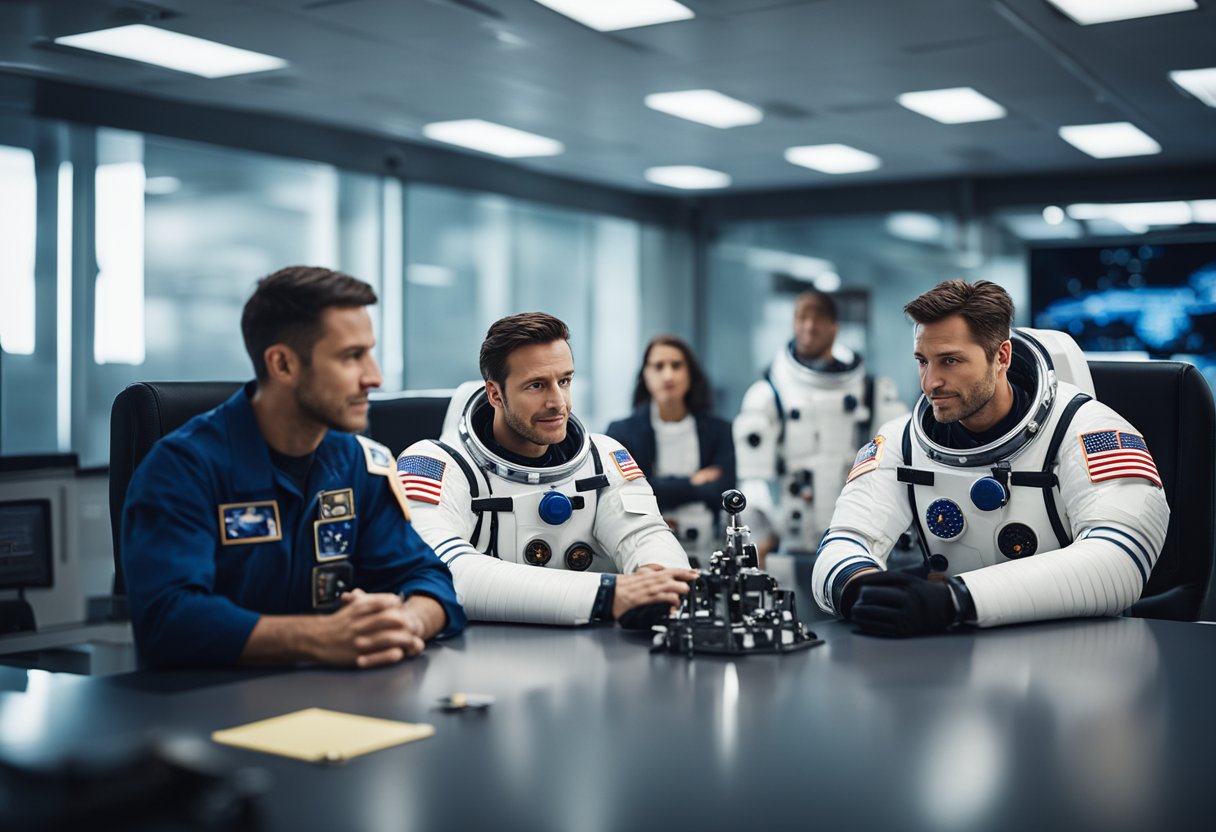
We address some of the most common inquiries regarding the rigorous preparation astronauts undergo before embarking on space missions.
Astronauts typically possess master’s degrees in STEM fields such as science, technology, engineering, or mathematics. Professional experience or time spent as pilot-in-command in jet aircraft is also required. NASA outlines these requirements in greater detail for those aspiring to join their ranks.
Training for NASA astronauts is a multi-year programme encompassing various types of exercises and simulations. This includes everything from underwater training to mock mission exercises. The Harvard Gazette provides insights into the length and breadth of this preparation.
Preparation for zero gravity involves activities that simulate the microgravity environment of space, such as neutral buoyancy training in a swimming pool and parabolic flight manoeuvres aboard specially equipped aircraft to experience brief periods of weightlessness.
The training period before an astronaut’s first mission can last around two years, but this duration varies based on mission requirements and the astronaut’s previous experience.
Physical requirements, including height, are crucial for ensuring that astronaut candidates can comfortably and safely fit into spacesuits and spacecraft equipment, which are designed to accommodate certain body proportions.
Astronauts consistently engage in cardiovascular conditioning, strength training, and flexibility exercises. These activities help maintain physical health and performance during the demanding conditions of space travel.